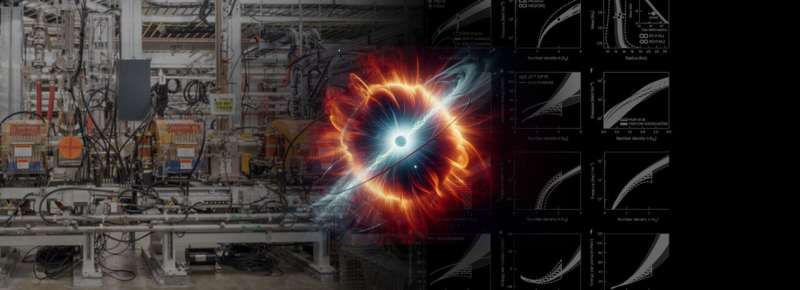This article has been reviewed according to Science X's editorial process and policies. Editors have highlighted the following attributes while ensuring the content's credibility:
fact-checked
peer-reviewed publication
trusted source
proofread
Merging nuclear physics experiments and astronomical observations to advance equation-of-state research

For most stars, neutron stars and black holes are their final resting places. When a supergiant star runs out of fuel, it expands and then rapidly collapses on itself. This act creates a neutron star—an object denser than our sun crammed into a space 13 to 18 miles wide. In such a heavily condensed stellar environment, most electrons combine with protons to make neutrons, resulting in a dense ball of matter consisting mainly of neutrons. Researchers try to understand the forces that control this process by creating dense matter in the laboratory through colliding neutron-rich nuclei and taking detailed measurements.
A research team—led by William Lynch and Betty Tsang at the Facility for Rare Isotope Beams (FRIB)—is focused on learning about neutrons in dense environments. Lynch, Tsang, and their collaborators used 20 years of experimental data from accelerator facilities and neutron-star observations to understand how particles interact in nuclear matter under a wide range of densities and pressures. The team wanted to determine how the ratio of neutrons to protons influences nuclear forces in a system. The team recently published its findings in Nature Astronomy.
"In nuclear physics, we are often confined to studying small systems, but we know exactly what particles are in our nuclear systems. Stars provide us an unbelievable opportunity, because they are large systems where nuclear physics plays a vital role, but we do not know for sure what particles are in their interiors," said Lynch, professor of nuclear physics at FRIB and in the Michigan State University (MSU) Department of Physics and Astronomy.
"They are interesting because the density varies greatly within such large systems. Nuclear forces play a dominant role within them, yet we know comparatively little about that role."
When a star with a mass that is 20–30 times that of the sun exhausts its fuel, it cools, collapses, and explodes in a supernova. After this explosion, only the matter in the deepest part of the star's interior coalesces to form a neutron star. This neutron star has no fuel to burn and over time, it radiates its remaining heat into the surrounding space.
Scientists expect that matter in the outer core of a cold neutron star is roughly similar to the matter in atomic nuclei but with three differences: neutron stars are much larger, they are denser in their interiors, and a larger fraction of their nucleons are neutrons. Deep within the inner core of a neutron star, the composition of neutron star matter remains a mystery.
"If experiments could provide more guidance about the forces that act in their interiors, we could make better predictions of their interior composition and of phase transitions within them. Neutron stars present a great research opportunity to combine these disciplines," said Lynch.
Accelerator facilities like FRIB help physicists study how subatomic particles interact under exotic conditions that are more common in neutron stars. When researchers compare these experiments to neutron-star observations, they can calculate the equation of state (EOS) of particles interacting in low-temperature, dense environments.
The EOS describes matter in specific conditions, and how its properties change with density. Solving EOS for a wide range of settings helps researchers understand the strong nuclear force's effects within dense objects, like neutron stars, in the cosmos. It also helps us learn more about neutron stars as they cool.
"This is the first time that we pulled together such a wealth of experimental data to explain the equation of state under these conditions, and this is important," said Tsang, professor of nuclear science at FRIB. "Previous efforts have used theory to explain the low-density and low-energy end of nuclear matter. We wanted to use all the data we had available to us from our previous experiences with accelerators to obtain a comprehensive equation of state."
Researchers seeking the EOS often calculate it at higher temperatures or lower densities. They then draw conclusions for the system across a wider range of conditions. However, physicists have come to understand in recent years that an EOS obtained from an experiment is only relevant for a specific range of densities.
As a result, the team needed to pull together data from a variety of accelerator experiments that used different measurements of colliding nuclei to replace those assumptions with data. "In this work, we asked two questions," said Lynch. "For a given measurement, what density does that measurement probe? After that, we asked what that measurement tells us about the equation of state at that density."
In its recent paper, the team combined its own experiments from accelerator facilities in the United States and Japan. It pulled together data from 12 different experimental constraints and three neutron-star observations. The researchers focused on determining the EOS for nuclear matter ranging from half to three times a nuclei's saturation density—the density found at the core of all stable nuclei. By producing this comprehensive EOS, the team provided new benchmarks for the larger nuclear physics and astrophysics communities to more accurately model interactions of nuclear matter.
The team improved its measurements at intermediate densities that neutron star observations do not provide through experiments at the GSI Helmholtz Centre for Heavy Ion Research in Germany, the RIKEN Nishina Center for Accelerator-Based Science in Japan, and the National Superconducting Cyclotron Laboratory (FRIB's predecessor). To enable key measurements discussed in this article, their experiments helped fund technical advances in data acquisition for active targets and time projection chambers that are being employed in many other experiments worldwide.
More information: Chun Yuen Tsang et al, Determination of the equation of state from nuclear experiments and neutron star observations, Nature Astronomy (2024). DOI: 10.1038/s41550-023-02161-z
Journal information: Nature Astronomy
Provided by Michigan State University





















